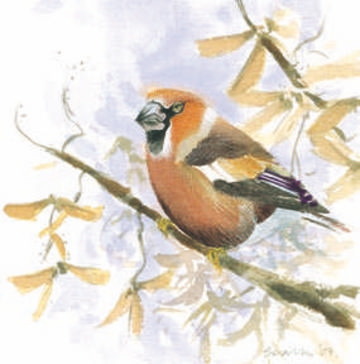Hawfinch (Coccothraustes coccothraustes)

Hawfinch © Ray Scally
This, the UK's largest finch, last bred in the county in 1990, when up to five pairs were found at separate sites in the Eccleston and Eaton Park area (SJ46B), ‘with at least three producing young and frequenting the usual cherry trees at the Rectory’ (CWBR). In 1991, they were ‘puzzlingly absent from their Cheshire stronghold’, and there have been no records even of possible breeding since then.
Cheshire is not alone in experiencing such a sudden loss of Hawfinches. The authors of the most recent analysis of its status, using county bird reports from across England and Wales, wrote that ‘Several counties have documented substantial declines at traditional sites which were previously noted for their wintering and/ or breeding concentrations of this species’, giving examples from widespread areas including sites in Norfolk, Staffordshire, Derbyshire, Oxfordshire and Kent (Langston et al 2002). Perhaps their loosely colonial nature makes them more prone to such mass desertions if conditions become not to their liking.
Nationally, it appears that their population rose in the late 1970s, was stable through the 1980s then dropped steeply from 1990 onwards, with the total in 1999 perhaps only half of that in 1990 (Langston et al 2002). They are on the amber list of species of conservation concern because of a moderate contraction of their UK breeding range between the two BTO national atlases (1968-72 and 1988-91), being found in 31% fewer 10-km squares in the second. Hawfinches have a strangely discontinuous breeding distribution, with strongholds in southeastern England, and in Gloucestershire, Derbyshire, Nottinghamshire, Yorkshire and Cumbria. An indication of its widespread but scarce status is given by the figures from the atlases of counties adjoining Cheshire: Hawfinches were recorded in the breeding season in 14 tetrads in Shropshire (1985-1990), 7 tetrads in Lancashire and North Merseyside (1997-2000) and 28 tetrads in Cumbria (1997-2001).
Their preferred habitat of deciduous woodland, especially old oaks and hornbeams, is not common in Cheshire and Wirral. Although they are best known for liking cherries, hornbeam seeds provide their staple diet in autumn and winter, with buds, especially of beech, in spring and insects, especially defoliating caterpillars, in summer (BTO Second Atlas).
It is thought that most British Hawfinches are sedentary (Migration Atlas). There are occasional autumn influxes of birds from continental Europe and Scandinavia, where more than one million pairs breed, and odd birds have been reported in the county in winter. One seen briefly at Marbury Country Park (SJ67N) on 31 December 2005 was the first record at any season for five years.
Sponsored by Sheila Blamire

